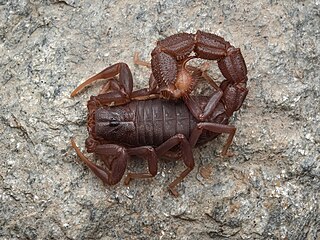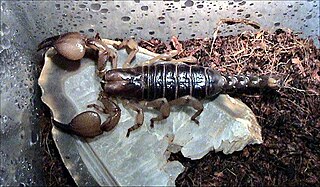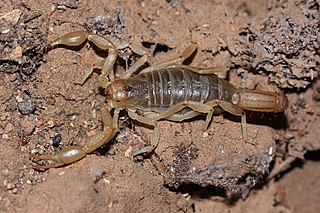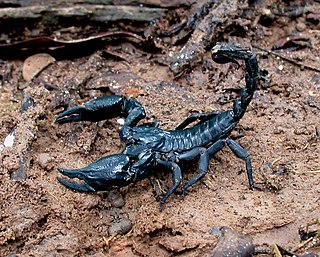
Scorpions are predatory arachnids of the order Scorpiones. They have eight legs, and are easily recognized by a pair of grasping pincers and a narrow, segmented tail, often carried in a characteristic forward curve over the back and always ending with a stinger. The evolutionary history of scorpions goes back 435 million years. They mainly live in deserts but have adapted to a wide range of environmental conditions, and can be found on all continents except Antarctica. There are over 2,500 described species, with 22 extant (living) families recognized to date. Their taxonomy is being revised to account for 21st-century genomic studies.

The emperor scorpion, Pandinus imperator, is a species of scorpion native to rainforests and savannas in West Africa. It is one of the largest scorpions in the world and lives for 6–8 years. Its body is black, but like other scorpions it glows pastel green or blue under ultraviolet light. It is a popular species in the pet trade, and is protected by CITES to prevent over-collecting that might affect the species' survival.

Parabuthus transvaalicus is a species of venomous scorpion from semi-arid parts of southern Africa.

Opistophthalmus is a genus of scorpions known commonly as burrowing scorpions, tricolored scorpions, serkets, or hissing scorpions. They are found predominantly in southern Africa. They are known for making deep and elaborate burrows.

Paravaejovis spinigerus, commonly known as the stripe-tailed scorpion or devil scorpion, is a species of scorpion in the family Vaejovidae. It is found in the south-western United States and north-western Mexico. Tultepec México

The Buthidae are the largest family of scorpions, containing about 100 genera and 1339 species as of 2022. A few very large genera are known, but a high number of species-poor or monotypic ones also exist. New taxa are being described at a rate of several new species per year. They have a cosmopolitan distribution throughout tropical and subtropical environments worldwide. Together with four other families, the Buthidae make up the superfamily Buthoidea. The family was established by Carl Ludwig Koch in 1837.

Hadogenes troglodytes is a species of scorpion from southern Africa. It is commonly known as the flat rock scorpion and commonly sold on the exotic pet market. It was once regarded as having the longest recorded body length of any scorpion, reaching up to 20 cm; however Heterometrus swammerdami currently holds the record for being the world's largest scorpion at 9 inches (23 cm) in length. May be confused with Hadogenes bicolor.

Heterometrus, whose members are also known by the collective vernacular name giant forest scorpions, is a genus of scorpions belonging to the family Scorpionidae. It is distributed widely across tropical and subtropical southeastern Asia, including Indonesia, Brunei, Malaysia, Myanmar, Philippines, Singapore, Cambodia, Laos, Thailand, Vietnam, India, and China (Hainan). It is notable for containing some of the largest living species of scorpions.

Mesobuthus eupeus is a polymorphic scorpion species belonging to the well-known family Buthidae. Commonly known as the lesser Asian scorpion or the mottled scorpion. It is thought to be the most widely dispersed species of the genus Mesobuthus, perhaps even of the family Buthidae.
Ikitoxin is a neurotoxin from the venom of the South African Spitting scorpion that targets voltage-sensitive sodium channels. It causes unprovoked jumps in mice following intracerebroventricular injections.

Uroplectes is a genus of scorpions in the family Buthidae. They are known commonly as the lesser thick-tailed scorpions. There are about 40 species distributed in the Afrotropical realm. They are most diverse in South Africa.

Parabuthus villosus, the black hairy thick-tailed scorpion, is a species of scorpion from southern Africa, where it ranges from the Northern Cape to Namibia. It is the largest species of the Buthidae, measuring up to 18 cm, and its diet may include lizards and mice. The species is often active at dawn and dusk, but takes refuge by day in a variety of shelters. It resembles Parabuthus transvaalicus, which is more strictly nocturnal, less hairy and with a more easterly distribution.
Parabuthus brevimanus is a species of scorpion from southern Africa, that ranges from southern Angola to Namibia and western South Africa, where its range extends south of the Orange River.
Parabutoxin (PBTx) is a Shaker-related voltage-gated K+ channel (Kvα1) inhibitor purified from different Parabuthus scorpion species found in southern Africa. It occurs in different forms: parabutoxin 1 (PBTx1), parabutoxin 2 (PBTx2), parabutoxin 3 (PBTx3) and parabutoxin (PBTx10). The different variants have different affinities towards Kvα1 channels.

Hadogenes is a genus of African scorpions. This genus is distinguished by its members which have an unusually flat overall appearance that allows them to quickly get in and out of the cracks and cervices that are generally abundant in their rocky habitats. Occurring in South Africa, Namibia, Botswana, Zimbabwe and Mozambique. Members of the genus also have special claws on their tarsus which allows them specialized maneuverability in their environments. The members of this genus have demonstrated an inability to travel across the sand and will perish in the heat when unable to find shelter for extended periods of time. The members of this genus are threatened by habitat loss due to mining as well and by poaching for the exotic pet trade.

Parabuthus granulatus, commonly known as the granulated thick-tailed scorpion, a large species of scorpion from the drier parts of southern Africa. It measures some 11.5 cm, and is dark yellow to brown in colour. It has a relatively small vesicle, but is one of the more venomous scorpion species of the region. Of all scorpion species, it causes most of the serious cases of envenomation in South Africa, and a few people die each year from their sting.

Lauren Esposito is the assistant curator and Schlinger chair of Arachnology at the California Academy of Sciences. She is the co-founder of the network 500 Queer Scientists.

Hemiscorpius lepturus is a species of scorpion in the family Hemiscorpiidae. It is found in deserts of the Middle East, especially in southern Iraq and Iran. These scorpions have long, thin tails and wide bodies and grow to 8 cm in males and 5.5 cm in females, allowing them to live in tight rock crevices. They are fairly solitary creatures. H. lepturus has mainly been studied to discover the components and effects of its venom, which is highly lethal and is responsible for most deaths due to scorpion sting in the Iran area. H. lepturus is the only scorpion not in the family Buthidae that is potentially lethal to humans; the Buthidae family is the largest and most abundant family of scorpions, containing many highly venomous species.

Uroplectes otjimbinguensis is a species of scorpion in the family Buthidae, endemic to Angola and Namibia.
Lychas buchari, also known as the yellow sand scorpion or Buchar's scorpion, is a species of small scorpion in the Buthidae family. It is native to Australia, and was first described in 1997 by Czech arachnologist Frantisek Kovarik.
















